What is this?
Proper fractional nutrition involves eating food in small portions over time. These are the conditions under which the proper functioning of the body is ensured. The required daily amount of calories is taken into account when creating a menu for each day. Overeating is excluded due to frequent consumption of small portions of food.
A balanced diet implies not only properly prepared healthy food, but also its regularity.
Basic principles of nutrition:
- five or six meals;
- small portion size (250-300 grams);
- timed eating;
- refusal to consume foods harmful to health, consumption of salt and sugar is allowed in small doses;
- compliance with the daily energy balance of the distribution of proteins, fats, carbohydrates.
Debunking myths
Supporters of this method of nutrition have many opponents who doubt the benefits of fractional nutrition. Arguments of opponents:
- They believe that the metabolic process cannot be increased by more than 20%. Acceleration can be carried out under the conditions of a strict daily routine, calculated to the smallest detail levels of physical activity, and a correctly observed sleep and rest schedule.
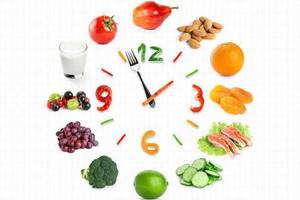
Having developed a conditioned reflex, the stomach will prepare in advance for the arrival of food, increasing the secretion of gastric juice.
Dieters argue that frequent snacking speeds up your metabolism. Opponents deny the claim that the human body, in breaks between meals of more than four hours, switches to the process of fat burning. Thereby negating the effect of accelerating metabolism;
- with fractional meals, the ratio of proteins, fats and carbohydrates must be carefully calculated and balanced. Not many people can make such a calculation. When calculating the menu of a fractional diet for weight loss, errors often occur when calculating proteins, fats, carbohydrates (hereinafter referred to as BZHU). Consumption of proteins is underestimated, and carbohydrates and fats are overestimated. Opponents remind that when proteins are reduced, metabolism slows down, which leads to the accumulation of adipose tissue. Energy consumption occurs due to the decomposition of protein, which means that muscle-binding tissue decreases in volume;
- A sharp reduction in the calorie content of food during fractional meals can lead obese people to starvation. Eating three meals a day will help reduce the number of calories without stress and ensure sufficient saturation of the body;
- There is no point in using such a daily routine for categories of workers and employees who work in shifts according to an unregulated production schedule.
Benefits of eating small meals
When a person eats two or three times a day, at least 6 hours pass between meals. During this time, hunger becomes intense and difficult to control. Eating 6 meals a day for weight loss is useful because food is distributed throughout the day in such a way that the intervals are reduced to three to four hours. Eating frequently allows you to be satisfied with small portions and create a menu of healthy foods. When there is no feeling of hunger, then there is no desire to indulge in unhealthy foods or sweets. It is important to control the entire daily food intake, calculate its calorie content, protein/fat and carbohydrate content.
The essence of fractional nutrition
The essence of the fractionated diet is to eat food frequently in small doses, which are quickly digested in the stomach. The gastrointestinal tract (hereinafter referred to as GIT) is not clogged with excess food and waste. This has a positive effect on the processes of digestion and assimilation of food. This diet can also be used by people who experience a constant feeling of hunger after eating, but after consulting with a nutritionist.

The standard scheme of three meals a day, consisting of breakfast, lunch and dinner, has a negative impact on metabolic processes and figure.
For muscle growth
Most nutritionists have come to the conclusion that fractional nutrition recipes are suitable for weightlifters and people trying to increase muscle size. The regimen allows you to eat more food without filling your stomach and helps maintain insulin at an optimal level. With intensive protein intake, the hormone promotes biceps growth. In this diet, it is advisable to focus on frequent consumption of protein foods in small portions. To achieve the desired effect, the calorie content increases by 500-1000 kilocalories.
For weight loss
Nutritionists say that eating food at regular intervals does not allow the body to accumulate excess fat. The weight loss effect occurs when the requirements are met, when the body expends more energy than it receives.
The diet is suitable for people who are accustomed to eating often, but in small portions. In the menu for fractional meals for weight loss, a reduction in the nutritional value of the daily diet is calculated by 500 calories from the required one.
Is there any harm?
Some supporters of fractional diets abuse the regime, trying to snack on high-calorie foods. The result is overeating, heaviness in the stomach and excess weight. Doctors recommend that all patients with endocrine disorders treat split meals with caution. Their hormonal control is impaired and cannot cope with the regulation of metabolism. Women suffering from infertility and amenorrhea, as well as all persons with disruptions in protein and carbohydrate metabolism, will have to give up fractional meals.
Doctors warn about certain risks to dental health. Since food is consumed frequently during the day, natural acids are constantly released to digest it. This negatively affects the condition of the teeth and can lead to the development of caries. It is very simple to minimize the risks - take good care of your mouth and visit the dentist periodically.
Pros and cons of the approach
Talking about fractional meals, we will consider the positive and negative aspects.

Prolonged absence of snacks puts the body in a state of stress; it begins to store fat deposits to compensate for the lack of energy.
Advantages
- does not need large restrictions on consumption products;
- hunger pangs are satisfied with small food doses;
- the body gets used to reducing the caloric content of food without stress;
- achievements in weight loss are stable, and if food intake requirements are met, they are almost irreversible;
- the vital activity of the body increases;
- The diet has no restrictions. Used for CVT diseases.
Difficulties and disadvantages of the mode
- the rules of fractional nutrition require a scrupulous calculation of the diet, systematic control of the calorie content of food, and adherence to consumption intervals;
- the regime is difficult to adapt to the lifestyle of individuals or does not always correspond to the possibilities for eating food;
- Frequent snacking increases the risk of dental disease;
- cannot be used by people dependent on food preferences;
- does not bring quick results.
Delicious recipes
The fractional meal menu for weight loss can be easily varied with simple recipes. In addition, this diet can be followed at home.
Breakfast
- Omelet with beans. Beat two eggs with milk, salt and soda. First lightly fry the beans, pour in the egg mixture. Add greens.
- Cottage cheese with berries and honey.
- Salad of cabbage, tomatoes, cheese and basil. Mix all ingredients, season with olive oil.
Lunches
- Puree with cauliflower and dill. You will need to boil 200 grams of potatoes, cauliflower, also 200 grams, add cottage cheese and milk (1 tbsp each), dill. All ingredients are mixed in a blender until smooth. Then you can serve it to the table.
- Omelette with bell pepper. Beat eggs with milk, add salt and soda. Cut bell peppers into the bottom of the frying pan and pour the egg mixture on top. Cook over low heat, covered, for 7-10 minutes. Then it is covered with herbs and served on the table.
- Meatball soup. Chopped potatoes are boiled in a small saucepan, carrots and onions are also added to the water after lightly frying. Meatballs are made from minced chicken, lightly salted and peppered, and added to the soup. After 30 minutes, you can add the greens and serve.
Dinners
- Pumpkin puree soup. All vegetables (carrots, potatoes, pumpkin) are chopped and boiled with a small amount of water over low heat. After they become soft, the soup is whipped with a blender. Boil the puree for another 10 minutes, add parsley when ready.
- Chicken and egg protein pie. For the dough, beat eggs with milk, salt, add flour, seasonings and baking powder. The dough should not be thick. The fillet is finely chopped, transferred to the dough, and cheese is added. Everything is thoroughly mixed and placed in a baking dish. The pie is cooked in the oven, preheated to 200 degrees, for 35-40 minutes.
- Stewed turkey with asparagus and peas. Peel the asparagus and cut into pieces. Cut the fillet into cubes and fry with flour. Pour in low fat cream and bring to a boil. Then add asparagus and simmer for 20 minutes with the lid closed. Serve with dill and parsley.
Snacks
- Grain bread with low fat curd cheese.
- Natural yogurt (100 g) with berries.
- Vegetable salad with nuts or avocado/cheese.
You need to try recipes for the menu for a month of fractional meals for weight loss, choose your favorite dishes and combine them. The right diet can be delicious.
Diet
The diet in question has a beneficial effect on the human body. Resistance to diseases, physical and psychological stress increases, and drowsiness disappears. Let's look at how to eat properly in small portions.

The interval between meals should not exceed 4 hours, so as not to create stressful situations for the body.
Fractional power mode
Meal times may vary, depending on the person. The regime is determined by the rhythm of life, working conditions, and the physical state of the individual. The main thing is to choose an appropriate food consumption regimen and strictly adhere to it.
The first breakfast should be no earlier than 30 minutes and no later than two hours after getting up. Dinner is served no later than two hours before going to bed.
Variant of food consumption mode:
- breakfast 6.30-7.00;
- first snack 9.30-10.00;
- lunch 12.30-13.00;
- second snack 15.30-16.00;
- dinner 17.00-18.00;
- small dinner (snack) until 20.00.
Menu for the week
A person’s daily diet should contain:
- 20-30% proteins;
- 50-60% carbohydrates;
- 10-20% fat.

Maintain a proper drinking regime by drinking about two liters of water per day. In this case, you should drink 30-60 minutes before or after meals.
An example of a fractional meal plan for weight loss menu for a week:
Monday
- breakfast - rice boiled in water, a piece of butter, an apple (preferably green), a cup of coffee;
- first snack - boiled egg, fresh cucumber;
- lunch - low-calorie baked fish, Chinese cabbage and cucumber salad;
- second snack - low-calorie cottage cheese, mint tea;
- dinner - boiled chicken, stewed vegetable stew.
Tuesday
- breakfast - low-fat cottage cheese with herbs, a piece of black bread, tea with cheese;
- first snack – cottage cheese with honey;
- lunch - chicken broth, fresh vegetable salad;
- second snack - one fruit (orange, kiwi), green tea;
- dinner - chicken fillet, two fresh tomatoes.
Wednesday
- breakfast - oatmeal with diluted milk with banana, honey, a cup of sweet green tea;
- first snack - a handful of walnuts, one apple, a cup of coffee;
- lunch - brown rice porridge with vegetables;
- second snack – cottage cheese casserole, banana;
- dinner - seafood salad with fresh cucumbers, tomatoes, sweet peppers, peas.
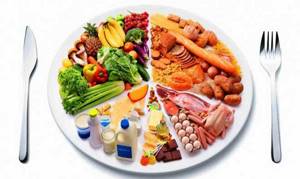
Fractional meals for weight loss with a clearly thought-out menu for a month will eliminate overeating and suppress the desire to snack on something sweet.
Thursday
- breakfast - oatmeal with diluted milk, fruit;
- first snack - low-fat yogurt, bread, a cup of coffee;
- lunch - sauerkraut salad, stewed hake;
- second snack - fresh vegetable salad with low-calorie sour cream;
- dinner - baked chicken, parmesan cheese, fresh cucumbers.
Friday
- breakfast – mashed potatoes, boiled egg, fresh cucumber;
- first snack – two kiwis, a cup of coffee;
- lunch – mushroom soup with rice, a piece of black bread with cheese;
- second snack – cottage cheese casserole with raisins;
- dinner – baked fish, seaweed;
Saturday
- breakfast - an omelet of two beaten eggs with milk, one fresh tomato, a cup of green tea;
- first snack – one banana and kiwi;
- lunch – baked potatoes, with stewed champignons, chicken breast, a glass of kefir;
- second snack – one apple;
- dinner – cottage cheese with baked apple.
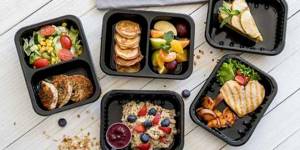
Nutritionists recommend eating at the same time every day, so when planning your diet, you should clearly think through your schedule taking into account your busy schedule.
Sunday
- breakfast – barley porridge with a piece of butter, a cup of weak tea;
- first snack – banana;
- lunch – boiled chicken, fresh vegetables;
- second snack – seafood salad, a cup of tomato juice;
- dinner - brown rice porridge with fish cutlets, a glass of tomato juice.
The menu can be calculated in detail based on individual preferences. You can use yoghurts, curds, and dietary fermented milk products sold in stores.
It is advisable to boil and bake food; fried foods contribute to obesity.
Products: permitted and prohibited
You can put an equal sign between the concepts of “fractional nutrition” and “rational nutrition”. Only healthy food will reinforce the positive effect of eating on a split schedule. Therefore, you will have to exclude all “harmful” foods from your diet:
- fast food category dishes;
- quick dishes “from the street” - fried pies, pasties, shawarma, hot dogs, burgers;
- products containing trans fats - cakes and pastries with butter cream, margarine, ketchups and spreads;
- baked goods made from white flour - buns, white bread, milk loaves;
- packaged instant food - pasta, soups, con-broths;
- sweets and dairy products containing dyes, flavors and flavor enhancers - yoghurts with additives, candies, chewing marmalade, chocolate bars;
- sweet carbonated drinks;
- meat products - pates, sausages, frankfurters, sausages, various smoked meats.
What should be in the diet of a person who eats rationally and fractionally:
- greens and vegetables - bell peppers, broccoli, asparagus, cauliflower, cucumbers, garlic, ginger, onions, tomatoes, sweet potatoes, green beans;
- fruit and berry variety - apples, bananas, avocados, blueberries, strawberries, citrus fruits are considered the healthiest;
- cereal products - oats, buckwheat, brown rice, lentils, beans;
- seeds and nuts - almonds, coconut pulp, walnuts, cashews, peanuts, flaxseed, sesame;
- sweets – dark chocolate, multi-grain baked goods;
- animal products - eggs, natural yogurt, butter, whole milk, chicken, beef and lamb;
- seafood - salmon, sardines, shellfish, shrimp, trout, tuna.
With such a list of permitted products, there will be no questions about how to create a menu. Don't forget to include vegetable oils in your diet - sunflower, olive and coconut.
Fractional meals for weight loss, 3 options
The principles of fractional nutrition involve frequent meals, without strict prohibitions on the consumption of most foods. A person stops feeling hungry, and the size of the stomach decreases.

Fractional meals for weight loss are a real godsend for those who are scared off by standard diets primarily by the feeling of hunger.
Option 1, reference to the feeling of hunger (grazing)
An option for people who prefer frequent snacks and do not have the opportunity to eat according to the system.
Nutrition principles:
- eat when hunger pangs appear;
- minimize calories and food doses;
- It is advisable that the breaks between meals be at least 30-45 minutes.
Not the best mode. It is difficult to maintain a balanced food intake, create and follow a menu. Frequent disruptions in food intake lead to an increase in calories. The SVT is constantly functioning, which has a bad effect on food digestion.
Option 2, breakfast lunch dinner and two snacks
The most favorable option.
Application principles:
- create a complete diet of five or six doses;
- maintain equal caloric content of food during main meals, snacks with low-calorie foods;
- use small single doses of consumption;
- The longest break in food should be no more than three hours.
The diet is appropriate for any work schedule. Small portions do not encourage overeating. This means that the feeling of hunger does not bother you throughout the day.

By increasing the number of meals and decreasing the serving size, you lose weight due to the fact that the body does not have time - in the usual sense - to get hungry.
Option 3, timed eating
A correctly calculated caloric intake and BJU ratio is suitable for athletes and people trying to lose weight. In this case, the fat layer is reduced, and muscle mass is maintained by eating foods high in protein.
Rules of application:
- the daily ration is divided into eight or ten parts;
- portion sizes are reduced to half or two thirds of the second option;
- breaks between snacks are no more than three hours;
- It is advisable to divide the daily food intake into even doses.
The daily water consumption rate is 1-2 liters. You should drink a glass of water 15-30 minutes before meals. It is not advisable to drink water while eating. When playing sports, on training days, drink water in small sips, every 15 minutes.
Menu for the week
An approximate menu of fractional meals for a week will help you navigate the first stages of switching to this regime.
- Breakfast: muesli with milk/oatmeal/bran porridge, apple/whole grain bread with butter/orange, tea or natural coffee (weak);
- Second breakfast: apple/yogurt/cottage cheese (70g)/piece of bread with cheese;
- Lunch: meat and vegetable salad/soup with bran bread/low-fat fish/chicken fillet with vegetables/vegetable soup;
- Afternoon snack: dried fruits/muesli with tea/cottage cheese/fruit and juice;
- Dinner: boiled and baked meat/fish, cheese with vegetable salad/baked vegetables;
An hour before bedtime, you can drink half a glass of natural yogurt and a glass of kefir.
How to create an individual menu
When drawing up a menu for fractional meals, the main thing is to correctly calculate the BJU for the day.
In the women's daily menu, the amount of fat should be slightly higher than for men. A woman needs fats; they help strengthen the immune system, protect the body from aging, and ensure timely, normal passage of life cycles.
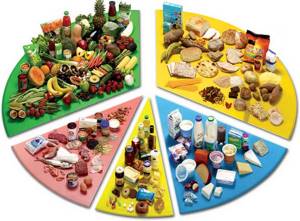
This approach to eating, judging by reviews, helps you lose weight by 5-7 kg per month - the specific result depends on the initial weight, menu and a number of additional factors.
Rules for creating a menu:
- proteins are distributed ½ between lunch and dinner;
- minimal use of animal fats and maximum use of natural fats;
- It is advisable to consume carbohydrates in the first half of the day. It is advisable not to consume sweets or flour. Why it is not recommended to eat a lot of sweets and starchy foods on a diet can be found by following the link.
When deciding to switch to fractional meals, it is advisable to prepare the menu for a week or a month in advance. In the specialized literature, there are enough examples of fractional food menus for the week, which makes the choice easier. The entire diet is compiled taking into account the tastes of the individual. Meals are divided by the number of servings of the selected fractional meal option.
The calorie content of fractional meals for weight loss and the monthly menu can be calculated using ready-made tables. It is advisable to edit the menu once every two weeks.
Tips for choosing a diet
The transition to such a diet should not cause an imbalance in life and promote health, both physical and emotional. To make it easier to get used to this method, let’s use the following tips:
- at first, it is advisable to use foods that are known for consumption;
- It is advisable to diversify the set of products. It is necessary to include more dietary, healthy dishes in the menu;
- the composition of the products must meet the physiological needs of the body;
- in the menu, take into account the daily norm of energy consumption in accordance with the weight, age, level of physical activity of the individual;
- when switching to a diet, it is advisable to consult a nutritionist;
- the menu should be simple, the dishes easy to prepare;
- It is advisable to eat hot dishes at lunch and dinner;
- serving size 250 grams (no more than 300 grams). To lose weight, the daily calorie intake for women (men) involved in sports should be 1200 (2000), respectively;
- Snacks should be as light as possible.
Not all vegetables and fruits are suitable for snacking. Rich in acids only intensify hunger pangs. When using, it is advisable to familiarize yourself with their qualities.

Fractional meals for weight loss allow you to smoothly and accurately reduce the daily amount of calories and physically reduce the amount of food - without unnecessary stress and acute hunger.
Distribution of proteins, fats and carbohydrates
With a balanced diet, BZHU are distributed according to the daily requirement:
- proteins - 50%
- fats - 30%
- carbohydrates – 20%.
When calculating calorie content you need to know:
- one gram of protein is equal to four kilocalories;
- one gram of fat is equal to nine kilocalories;
- One gram of carbohydrates equals four kilocalories.
To calculate the daily fat intake, you need to multiply the person’s weight in kilograms by 0.6. The result will reflect the daily fat requirement in grams.
Calorie distribution of the daily menu:
- breakfast should be hearty, calorie content - 25%;
- first snack - no more than 5%;
- lunch - 35%;
- the second snack corresponds to the first;
- dinner - 25%;
- before bedtime - no more than 5% of calories, you can drink a glass of low-fat kefir or herbal tea.
The fractionated diet is not a panacea for weight loss. When using it, you must follow the established rules. To speed up weight loss, you need to move and lead an active lifestyle. Take walks, jogs, stop using the elevator, go in for sports, dance.
Basic Rules
The principles of fractional nutrition are based on frequent food consumption - 5-6 times a day. You need to eat in small portions at the same time. Products in the diet must comply with the rules of the PP: junk food is excluded, sugar and salt are allowed in minimal quantities. A balanced menu is a competent ratio of BZHU without bias in any direction. Fractional meals are recommended not only for weight loss, but also in therapeutic dietetics. Thus, you can get rid of flatulence, diarrhea, nausea, heaviness and bloating.
Rules for fractional meals for weight loss for each meal:
Breakfast:
- must be satisfying;
- ideally – grain porridge with milk and fruit;
- include the most high-calorie foods from the daily diet;
- most carbohydrates are for breakfast;
- 25% of all calories calculated for the day.
Lunch:
- nuts, berries, fruits and vegetables;
- 5% of all calories.
Dinner:
- necessarily hot dishes;
- 35% of all calories.
Afternoon snack:
- milkshakes, smoothies, fresh juice, fermented milk products;
- 5% of daily calories.
Dinner:
- hot;
- foods high in protein and fiber;
- ideally – boiled (stewed) vegetables, meat or fish (not fatty varieties), seafood;
- 25% of all calories.
Before bedtime:
- herbal tea, kefir;
- 5% of daily calories;
- at least an hour before bedtime.
By adhering to such principles, you can not only lose weight, but also improve your overall well-being. The great advantage of frequent meals is that the result of losing weight will be stable. Switching to a new diet plan is not easy; sticking to some principles requires patience and willpower. It is worth remembering that this is not a diet regimen, but a lifestyle.
How to calculate BZHU
BJU is an abbreviation for proteins/fats/carbohydrates. The calculation of the BJU ratio is made taking into account all the characteristics of the human body, namely:
- body weight;
- age;
- gender;
- growth;
- lifestyle.
There is no single formula that suits everyone. Athletes calculate according to the proportion 1:1:4. But this option is not suitable for weight loss, as it contains a lot of carbohydrates. Adipose tissue is formed due to the body’s ability to store carbohydrates in reserve, so their quantity must be limited. The fractional meal menu table for the week for men will differ from the scheme for women. Most often, the calculation is made using the formula:
KBZHU = weight (kg) * 24.2 (men) or 22 (women);
The resulting figure corresponds to the daily intake of proteins/fats/carbohydrates. And this indicator must be adhered to when splitting meals for weight loss. The best proportion for fighting extra pounds is considered to be 4:2:4.
Table of BZHU for women and men for each serving:
| floor | Squirrels | Fats | Carbohydrates |
| Women | 30% from 250 mg | From 5-15 from 250 mg | 60% of 250mg |
| Men | 30% from 350 mg | 5-15 from 350 mg | 60% of 350mg |
In the examples of fractional nutrition menus for weight loss, the main requirement is taken into account - you need to spend more calories than you consume. Therefore, physical activity is taken into account in the calculations. Let's say a girl weighs 75 kg and she needs to lose weight to 55 kg. To do this, she needs to consume no more than 55 * 22 = 1210 calories. The ratio of BJU can be changed, but the proportion of proteins should always exceed the amount of fat.
Authorized Products
With fractional meals, the diet is combined from low-calorie dishes. As a rule, the menu includes low-fat soups, meat, fish, cereals, whole grain bread, and cereals. Also allowed are kefir, milk, yoghurts, cottage cheese (not fatty), fermented baked milk.
| Vegetables (broccoli, cabbage, eggplant, zucchini, onions, carrots, asparagus and others) | 2-3 pcs. |
| Fruits (tangerines, kiwi, grapefruits, pomegranate, peach, pear and others) | 2-3 pcs. |
| Greens (dill, sorrel, arugula, lettuce, parsley, fennel, etc.) | Unlimited amount |
| Meat and fish (veal, turkey, pork liver, hake, perch and more) | 100-200grams |
| Dairy and fermented milk products | 100-200 grams |
Important: The total calorie content in the daily menu depends on physical activity. For active men and women, one nutrition plan; for a passive lifestyle, portions are reduced.
The fractional meal menu for weight loss is compiled exclusively from the permitted products indicated in the table. For women, the calorie content of a serving is 250-300 (with light loads), 400 (with regular training). For men – 400-480 (low activity), up to 550 kcal – with increased loads.
Optimal nutrient content per serving
In a fractional nutrition diet for weight loss, it is important to adhere to the correct ratio of dietary fatty acids in the diet. Nutritionists have calculated that the ideal portion for women is 250 mg, for men – 350 mg. Of these: proteins – 30%, fats – 5-15%, carbohydrates – 60%. To accurately determine the weight of a portion, you need a kitchen scale.
Interesting. The Finns came up with a diet called the “plate model.” This method in action looks like this: a plate with a diameter of 20-24 cm is conventionally divided into equal parts, after which the half is divided in two. One half and two quarters will come out. 1/5 is filled with vegetables, 1/25 with complex carbohydrates, 1/25 with proteins. The weight of half with vegetables is 500 g (foods can be eaten stewed, boiled, fresh or steamed), the carbohydrate part is 100-150 g (3/4 cup), the protein part (fish or meat) is from 80 to 120 grams. This eating pattern will help you lose weight without harming the vital functions of the body.
How to switch to multiple meals?
Nutritionists advise sticking to 5-6 meals a day to lose weight. But how to start eating fractionally? There are some tips:
- intervals between meals – 3-3.5 hours;
- breakfast – 8 am;
- afternoon snack – 11 a.m.;
- lunch – 14.00;
- afternoon tea – 17.00;
- dinner -20.00.
For weight loss, it is important not only to eat fractionally, but also to maintain a normal water-salt balance. You need to drink at least 2 liters of water a day, preferably half an hour before meals and 1.5 hours after.
Video to help!
This video will help you understand how to eat smaller meals to lose weight. With this approach to food consumption, a person does not feel hungry, because the body does not require a lot of energy and calories. The daily diet becomes 15-20% less caloric. When consumed frequently, foods are digested faster and nutrients are better absorbed. With such a proper nutrition menu for every day, the general condition of the body improves, as the load on the digestive system is reduced.
Better than a diet
Unlike diets, fractional meals are not based on sudden changes in your usual diet . After all, as already mentioned, it is enough to give up harmful products, which is not so difficult.
During a diet, in order to achieve weight loss, you have to constantly suffer from hunger. And this often leads to a deterioration in health.
With fractional meals according to a properly designed menu, for example, for a month, a person often eats food. Thus, the feeling of hunger has no chance. The result will be good health and excellent mood.
Stress for the body can result from a sharp decrease in caloric content of food, as happens with diets. But with fractional meals, calorie content decreases very smoothly and gradually, so the body does not even notice it .
When the diet stops, the starved body seems to attack the calories newly added to the diet. Now it not only replenishes the missing fats, but will also actively store it in reserve.

Ending a diet often triggers a return to old eating habits
Therefore, the effect of thinness after finishing the diet may not only disappear, but there is a considerable chance of gaining even more extra pounds. And in a very short period of time.
With fractional meals, the body does not feel great deprivation. On the contrary, the gastrointestinal tract is already accustomed to taking food in very small portions, so it is no longer able to accept a large amount of food . And even more so heavy and high-calorie food, which he may even reject.
Therefore, the effect of such weight loss will last much longer than after a diet. In addition, after fractional nutrition in problem areas, fat deposition stops.
The next advantage is that fractional nutrition is indicated not only for healthy people. Very often it is used to restore people with any ailments. Thus, it is medicinal in nature. While diet can cause damage to health.
Small portions are easily digested by the body, leaving a feeling of lightness and comfort . During a diet, the body is constantly under some kind of tension.
Benefit and result
The essence of fractional nutrition for weight loss is that it can normalize the metabolism in the body. If the monthly menu is drawn up correctly, then every time food enters the stomach, energy is expended to digest the food. And since meals must be frequent, a lot of energy is required.
As a result, fats are burned, not only newly arrived fats, but also those previously deposited by the body. In addition, when consuming small portions, all the nutrients provided have time to be absorbed.
This promotes metabolic processes in the body. Which, in turn, leads to good health, health and good mood.
How to limit yourself in food
We must not forget about water, which is an integral part of fractional nutrition. The daily rate of water consumed should be at least 2 liters . If there is heavy physical activity, then the norm automatically increases.

Water is necessary for the body to function properly
It is better to drink water half an hour before a meal, and not earlier than an hour and a half after it. This is another trick. After all, once in the stomach, water takes up a certain amount of space. This way, the stomach will not be empty and will not send a signal to the brain about feeling hungry.
During a meal, there is little space left in the stomach, again due to water, so the feeling of fullness comes earlier . This eliminates the possibility of eating too much.
Schedule by hour
An approximate daily diet for a person who wakes up at 7 and goes to bed at 22 looks like this:
7:00 - a glass of warm water with 30 ml of lemon juice;
7:30 - breakfast of oatmeal on water with sunflower seeds, sesame seeds, flax, chia and raisins - 250 g.
9:00 - a cup of green, unsweetened tea with lemon;
9:30 - 100 g of low-fat cottage cheese - 150 g, a tablespoon of Siberian fiber, 30 g of fresh berries;
11:30 - 2 glasses of water;
12:00 - green peas, broccoli and cauliflower puree - 250 g;
14:30 - glass of water;
15:00 - 200 g of boiled beef, fresh cucumber;
17:30 - unsweetened green tea with lemon;
18:00 - boiled sea fish - 150 g, white cabbage and greens salad - 100 g;
21:00 - a glass of kefir with a tablespoon of Siberian fiber.
Each person is recommended to apply the proposed diet to his usual regimen, observing time intervals between meals.
Serving sizes
The most difficult thing at the beginning of fractional nutrition is to limit yourself to a small portion size per meal. The entire daily diet should be about 2000, maximum 2200 kcal . It is divided into three main ones (400-500 kcal each) and two - three intermediate ones (200-250 kcal).
It is worth noting that portion sizes directly depend on a person’s lifestyle. The less active your lifestyle, the fewer calories you should consume.
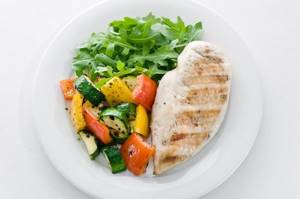
A small portion of meat with vegetables corresponds to the required amount of calories.
When switching to fractional meals, you need to give up a lunch of three high-calorie dishes. You can eat meat and vegetables after soup, but the total size of these portions must correspond to the permissible number of calories.
When you are writing out fractional meals for weight loss, a menu for the month, you can use a little trick to more accurately determine the required amount of food.
Two clenched and brought together fists show the volume of their owner's stomach
- But this is the volume of the stomach in the correct state. In people prone to overeating, the stomach is stretched.
- Therefore, in order to normalize the size of the stomach, it is necessary to consume at one time a volume of food equal to two clenched fists.
- A woman’s palm clenched into a fist is approximately 200g, and a man’s is 250g.
- A handful contains about half a glass of boiled cereal or pasta, as well as about two tablespoons of liquid.
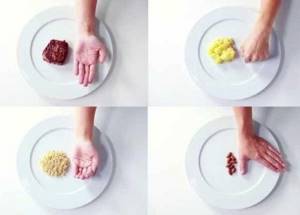
Measures in hand to determine serving size
- But the thumbnail corresponds to five grams, i.e. one second teaspoon.
- The amount of butter consumed per day should be equal to two nails.
- The size of a tablespoon can be equal to two thumbs folded together.
- Two fists fit one portion of vegetables, fruits fit in one fist.
- One palm corresponds to the norm of meat, fish or chicken, as well as dairy products.
- A serving of soup should not exceed the size of one fist.
You may find this article useful: Kim Protasov’s diet - description by week
Where to begin
Of course, it is quite difficult to suddenly change your diet and start eating according to a new method. Therefore, it is better to do it gradually.
It would be better if the transition to fractional meals begins during vacation or weekends . In a calm home environment, it will be easier to keep track of your meal schedule than at work.
The first thing to do is adjust the serving size , leaving the contents the same. If previously the daily diet was divided into two doses in large quantities, then you need to reduce the serving size by 2 times.
Then, gradually increase the size of one meal to the volume of a glass . To do this, you can choose a suitable bowl.
By this point, the nutrition schedule should already be correctly adjusted.
It should be convenient and mean every meal at the same time . And in order not to miss time, it is better to make a schedule in writing and place it in a visible place.

You need to make a meal plan and stick to it
You can also create a reminder using your mobile phone or download a special program. The same method can be used to count calories consumed. Or keep a nice notebook and just write down everything that was eaten.
Now you can take care of the components of your diet.









